The global cosmetic product packaging market is forecast to rise from USD 29,785.8 million in 2025 to USD 48,518 million in 2035, recording a CAGR of 5% and total growth of 62.9%. The cosmetic product packaging market size is expected to expand by nearly 1.63X, but growth patterns vary sharply across regions, creating structural imbalances in adoption, material use, and premiumization levels.
North America demonstrates steady expansion driven by premium beauty and personal care categories. Strong penetration of luxury cosmetics brands and rising preference for sustainable packaging materials underpin growth. However, mature retail structures and consolidated supply chains limit the pace of expansion compared to Asia Pacific. Demand in the United States is shaped by consumer willingness to pay for premium and eco-friendly packaging formats, while Canada shows incremental adoption in natural and organic cosmetic lines.
Europe remains the global hub for luxury and high-end cosmetic packaging, particularly in France, Italy, and Germany. Regulatory emphasis on recyclability and strict EU packaging directives push brands toward glass, aluminum, and recyclable plastics. Growth is steady but moderated by market maturity. Imbalances are visible in the reliance on established luxury clusters, leaving Eastern Europe to trail in packaging innovation and adoption rates.
Asia Pacific leads in absolute growth, supported by mass-market cosmetics in China, South Korea, Japan, and India. Rising disposable incomes, urban expansion, and the influence of K-beauty and J-beauty trends amplify packaging innovation, particularly in airless pumps, refillable jars, and miniaturized formats suited for e-commerce. Asia Pacific not only consumes the largest volumes but also drives design innovation, creating a regional imbalance where growth outpaces Europe and North America.
Latin America shows moderate growth led by Brazil and Mexico. Consumer preference for affordable yet aesthetically appealing packaging pushes manufacturers to balance cost and visual appeal. Currency fluctuations and uneven retail development create barriers, producing slower adoption compared with Asia Pacific and Europe.
Middle East & Africa remain emerging markets where luxury packaging demand is concentrated in Gulf states such as the UAE and Saudi Arabia, while African markets focus on affordable personal care products. Limited regional manufacturing capacity makes these regions dependent on imports, widening the growth imbalance compared with Asia Pacific’s self-sufficient ecosystem.
The regional growth imbalance in cosmetic product packaging is defined by Asia Pacific’s high-volume expansion, Europe’s regulatory-driven stability, North America’s premium-focused maturity, and slower adoption in Latin America and Africa. By 2035, Asia Pacific is expected to dominate incremental growth, while Europe and North America rely more on premiumization and sustainability to sustain demand, leaving emerging regions trailing in both innovation and scale.
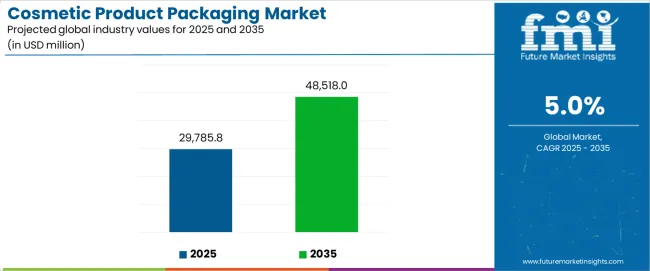
Between 2025 and 2030, the cosmetic product packaging market is projected to expand from USD 29,785.8 million to USD 36,204.9 million, resulting in a value increase of USD 6,419.1 million, which represents 34.3% of the total forecast growth for the decade. This phase of development will be shaped by increasing adoption of smart packaging technologies, rising demand for premium glass containers, and growing emphasis on personalized packaging solutions with enhanced aesthetic appeal characteristics. Beauty brands are expanding their packaging innovation capabilities to address the growing demand for luxury presentation, product protection applications, and sustainable material requirements.
| Metric | Value |
|---|---|
| Estimated Value in (2025E) | USD 29,785.8 million |
| Forecast Value in (2035F) | USD 48,518 million |
| Forecast CAGR (2025 to 2035) | 5% |
From 2030 to 2035, the cosmetic product packaging market is forecast to grow from USD 36,204.9 million to USD 48,518 million, adding another USD 12,313.1 million, which constitutes 65.7% of the overall ten-year expansion. This period is expected to be characterized by the expansion of digital printing technologies, the integration of smart labeling systems, and the development of multi-functional packaging platforms with enhanced user experience capabilities. The growing adoption of omnichannel beauty retail will drive demand for cosmetic packaging with superior visual appeal and compatibility with e-commerce shipping requirements across global distribution networks.
Between 2020 and 2025, the cosmetic product packaging market experienced robust growth, driven by increasing demand for premium beauty products and growing recognition of packaging as essential differentiators for brand positioning across luxury cosmetics, mass market beauty, and specialty personal care applications. The cosmetic product packaging market developed as beauty brands recognized the potential for innovative packaging to enhance product perception while maintaining product integrity and enabling distinctive brand experiences. Technological advancement in printing technologies and material science began emphasizing the critical importance of maintaining visual appeal and functional performance in diverse retail environments.
Market expansion is being supported by the increasing global demand for premium beauty products and the corresponding need for sophisticated packaging systems that can provide superior brand differentiation and visual appeal while enabling enhanced product protection and consumer experience across various beauty and personal care applications. Modern beauty brands and cosmetic manufacturers are increasingly focused on implementing packaging technologies that can deliver distinctive aesthetics, prevent product degradation, and provide consistent performance throughout complex distribution channels and diverse retail environments. Cosmetic product packaging's proven ability to deliver exceptional brand positioning against competitive products, enable premium market positioning, and support cost-effective marketing strategies make them essential components for contemporary beauty industry operations.
The growing emphasis on beauty product premiumization and brand differentiation is driving demand for cosmetic product packaging that can support luxury positioning requirements, improve consumer engagement outcomes, and enable innovative presentation systems. Beauty brands' preference for packaging that combines visual excellence with functional performance and resource efficiency is creating opportunities for advanced packaging implementations. The rising influence of social media marketing and digital brand presentation is also contributing to increased demand for cosmetic product packaging that can provide photogenic appeal, unboxing experiences, and reliable performance across extended product lifecycles.
The cosmetic product packaging market is poised for rapid growth and transformation. As industries across beauty, personal care, luxury cosmetics, and specialty treatments seek solutions that deliver exceptional visual appeal, brand differentiation, and consumer engagement, cosmetic product packaging is gaining prominence not just as protective containers but as strategic enablers of brand positioning and marketing effectiveness.
Rising premium beauty adoption in Asia-Pacific and expanding luxury cosmetics initiatives globally amplify demand, while manufacturers are leveraging innovations in smart packaging systems, sustainable material technologies, and integrated digital features.
Pathways like premium glass containers, smart packaging platforms, and personalized decoration solutions promise strong margin uplift, especially in luxury beauty segments. Geographic expansion and technology integration will capture volume, particularly where local beauty preferences and premium positioning are critical. Regulatory support around product safety standards, material compliance requirements, and brand authenticity protection give structural support.
The cosmetic product packaging market is segmented by material type, application, packaging format, distribution channel, and region. By material type, the cosmetic product packaging market is divided into plastic, glass, metal, and paper & paperboard categories. By application, it covers skincare, makeup, fragrance, hair care, and others. By packaging format, the market includes bottles, jars, tubes, compacts, and pumps & dispensers. By distribution channel, it is categorized into retail stores, e-commerce, specialty stores, and direct-to-consumer. Regionally, the market is divided into North America, Europe, East Asia, South Asia & Pacific, Latin America, and the Middle East & Africa.
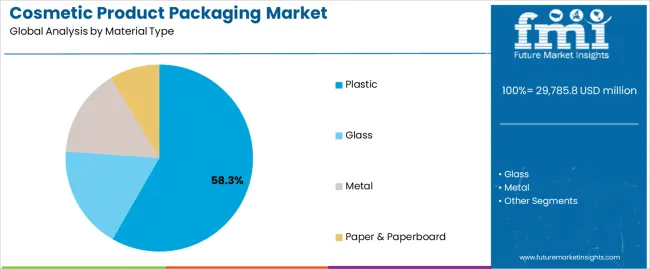
The plastic material segment is projected to account for 58.3% of the cosmetic product packaging market in 2025, reaffirming its position as the leading material category. Beauty brands and cosmetic manufacturers increasingly utilize plastic packaging for its superior design flexibility capabilities when operating across diverse product categories, excellent cost-effectiveness characteristics, and versatility in applications ranging from mass market cosmetics to specialty personal care products. Plastic packaging technology's advanced molding system capabilities and lightweight properties directly address the industry requirements for efficient production in high-volume manufacturing environments.
This material segment forms the foundation of modern cosmetic packaging operations, as it represents the packaging type with the greatest versatility and established market demand across multiple application categories and beauty sectors. Manufacturer investments in recycled plastic technologies and biodegradable material compatibility continue to strengthen adoption among beauty brands and packaging suppliers. With companies prioritizing cost efficiency and design innovation, plastic packaging solutions align with both performance requirements and economic optimization objectives, making them the central component of comprehensive beauty packaging strategies.
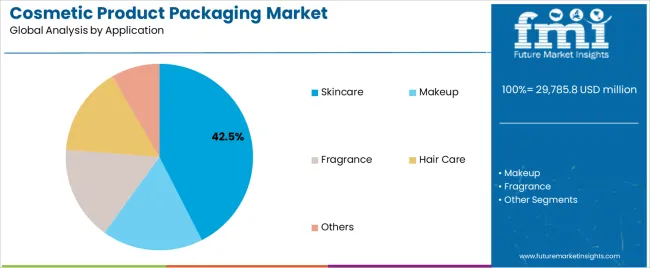
Skincare applications are projected to represent 42.5% of cosmetic product packaging demand in 2025, underscoring their critical role as the primary beauty consumers of sophisticated packaging technology for product protection, ingredient preservation, and premium presentation applications. Skincare brands prefer specialized packaging for their exceptional barrier protection capabilities, airless dispensing characteristics, and ability to maintain product efficacy while ensuring superior user experience throughout diverse treatment protocols. Positioned as essential components for modern skincare operations, cosmetic packaging offers both functional advantages and brand differentiation benefits.
The segment is supported by continuous innovation in barrier coating technologies and the growing availability of specialized dispensing systems that enable precise dosing applications with enhanced product preservation and premium aesthetic appeal capabilities. Additionally, skincare manufacturers are investing in smart packaging systems to support anti-aging product positioning and luxury market requirements. As premium skincare demand becomes more prevalent and ingredient stability requirements increase, skincare applications will continue to dominate the end-use market while supporting advanced beauty innovation utilization and brand positioning strategies.
The cosmetic product packaging market is advancing rapidly due to increasing demand for premium beauty products and growing adoption of innovative packaging solutions that provide superior brand differentiation and visual appeal while enabling enhanced product protection across diverse beauty and personal care applications. However, the cosmetic product packaging market faces challenges, including rising raw material costs, regulatory compliance complexity, and the need for advanced manufacturing capabilities and quality control systems. Innovation in smart packaging technologies and material science continues to influence product development and market expansion patterns.
The growing adoption of NFC technology integration, QR code implementation, and digital authentication systems is enabling manufacturers to produce advanced cosmetic packaging with superior consumer engagement capabilities, enhanced brand protection functionalities, and interactive user experience features. Advanced smart packaging provides improved product verification while allowing more efficient supply chain tracking and consistent brand communication across various retail channels and distribution networks. Manufacturers are increasingly recognizing the competitive advantages of intelligent packaging capabilities for premium market positioning and consumer relationship differentiation.
Modern cosmetic packaging producers are incorporating sustainable glass alternatives, metallic finishes, and advanced decoration techniques to enhance visual appeal, enable luxury positioning capabilities, and deliver value-added solutions to beauty customers. These technologies improve brand perception while enabling new aesthetic possibilities, including tactile surface treatments, holographic effects, and reduced environmental impact. Advanced material integration also allows manufacturers to support comprehensive brand differentiation systems and beauty market premiumization beyond traditional basic packaging approaches.
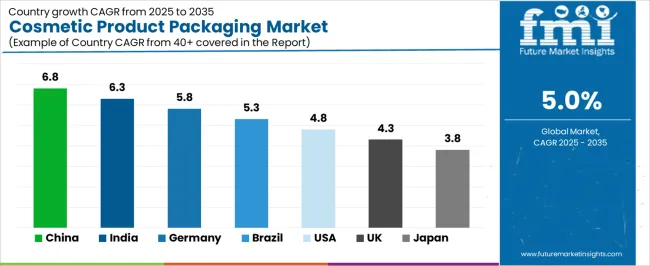
| Country | CAGR (2025-2035) |
|---|---|
| China | 6.8% |
| India | 6.3% |
| Germany | 5.8% |
| Brazil | 5.3% |
| USA | 4.8% |
| UK | 4.3% |
| Japan | 3.8% |
The cosmetic product packaging market is experiencing strong growth globally, with China leading at a 6.8% CAGR through 2035, driven by the expanding beauty industry modernization programs, growing luxury cosmetics adoption, and significant investment in packaging technology development. India follows at 6.3%, supported by rising disposable income levels, increasing beauty awareness initiatives, and growing premium personal care demand.
Germany shows growth at 5.8%, emphasizing packaging innovation excellence and advanced manufacturing technology development. Brazil records 5.3%, focusing on expanding beauty market participation and cosmetic consumption growth. The USA demonstrates 4.8% growth, prioritizing premium beauty standards and packaging innovation excellence. The UK exhibits 4.3% growth, emphasizing luxury beauty positioning and advanced packaging development. Japan shows 3.8% growth, supported by sophisticated beauty culture traditions and premium packaging concentration.
The report covers an in-depth analysis of 40+ countries, the top-performing countries are highlighted below.
Revenue from cosmetic product packaging in China is projected to exhibit exceptional growth with a CAGR of 6.8% through 2035, driven by expanding beauty industry modernization programs and rapidly growing luxury cosmetics adoption supported by rising consumer spending and increasing beauty awareness development. The country's strong position in manufacturing capabilities and increasing investment in premium packaging infrastructure are creating substantial demand for advanced cosmetic packaging solutions. Major beauty brands and cosmetic manufacturers are establishing comprehensive packaging supply capabilities to serve both domestic beauty demand and international export markets.
Revenue from cosmetic product packaging in India is expanding at a CAGR of 6.3%, supported by the country's growing middle class consumer base, expanding beauty awareness campaigns, and increasing adoption of premium personal care products. The country's initiatives promoting beauty industry development and growing consumer spending power are driving requirements for advanced packaging capabilities. International beauty brands and domestic manufacturers are establishing extensive production and distribution capabilities to address the growing demand for cosmetic packaging products.
Revenue from cosmetic product packaging in Germany is expanding at a CAGR of 5.8%, supported by the country's advanced manufacturing capabilities, strong emphasis on packaging technology innovation, and robust demand for high-performance beauty packaging in premium cosmetics and luxury personal care applications. The nation's mature beauty industry and quality-focused operations are driving sophisticated packaging systems throughout the cosmetics sector. Leading manufacturers and technology providers are investing extensively in automation systems and premium material technologies to serve both domestic and international markets.
Revenue from cosmetic product packaging in Brazil is growing at a CAGR of 5.3%, driven by the country's expanding beauty culture, growing consumer spending power, and increasing investment in cosmetic industry development. Brazil's large consumer market and commitment to beauty industry expansion are supporting demand for diverse packaging solutions across multiple beauty product segments. Manufacturers are establishing comprehensive supply capabilities to serve the growing domestic market and regional export opportunities.
Revenue from cosmetic product packaging in the USA is expanding at a CAGR of 4.8%, supported by the country's advanced beauty industry sector, strategic focus on premium positioning, and established luxury cosmetics capabilities. The USA's beauty innovation leadership and technology integration are driving demand for cosmetic packaging in premium brands, specialty beauty products, and advanced personal care applications. Manufacturers are investing in comprehensive technology development to serve both domestic beauty markets and international luxury applications.
Revenue from cosmetic product packaging in the UK is growing at a CAGR of 4.3%, driven by the country's focus on luxury beauty development, emphasis on premium brand positioning, and strong position in international beauty trade. The UK's established beauty innovation capabilities and commitment to industry excellence are supporting investment in advanced packaging technologies throughout major beauty centers. Industry leaders are establishing comprehensive brand positioning systems to serve domestic beauty operations and international luxury applications.
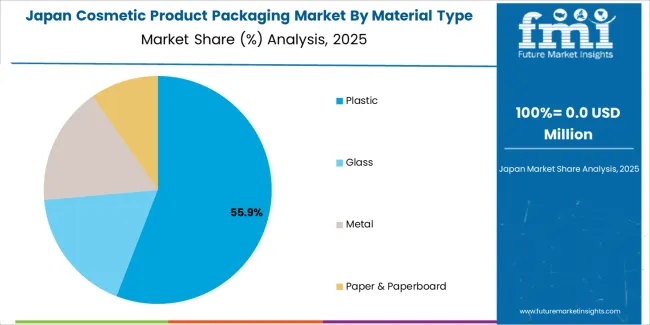
Revenue from cosmetic product packaging in Japan is expanding at a CAGR of 3.8%, supported by the country's sophisticated beauty culture traditions, growing premium cosmetics sector, and strategic emphasis on packaging excellence development. Japan's prestige beauty capabilities and integrated quality systems are driving demand for advanced cosmetic packaging in luxury beauty products, specialized skincare, and high-performance personal care applications. Leading manufacturers are investing in specialized capabilities to serve the stringent requirements of premium beauty and luxury cosmetics industries.
The cosmetic product packaging market in Europe is projected to grow from USD 7,156.6 million in 2025 to USD 11,644.3 million by 2035, registering a CAGR of 5% over the forecast period. Germany is expected to maintain its leadership position with a 28.4% market share in 2025, declining slightly to 28.1% by 2035, supported by its strong packaging manufacturing sector, advanced beauty industry capabilities, and comprehensive cosmetic packaging infrastructure serving diverse beauty applications across Europe.
France follows with a 22.1% share in 2025, projected to reach 22.4% by 2035, driven by robust demand for luxury cosmetic packaging, premium beauty brand concentration, and sophisticated packaging design applications, combined with established fashion and beauty heritage and luxury market expertise. The United Kingdom holds a 18.6% share in 2025, expected to reach 18.9% by 2035, supported by strong beauty retail sector and growing premium packaging activities.
Italy commands a 15.2% share in 2025, projected to reach 15.4% by 2035, while Spain accounts for 8.7% in 2025, expected to reach 8.9% by 2035. The Netherlands maintains a 3.8% share in 2025, growing to 3.9% by 2035. The Rest of Europe region, including Nordic countries, Eastern Europe, Belgium, Poland, and other nations, is anticipated to maintain momentum, with its collective share moving from 3.2% to 2.4% by 2035, attributed to increasing beauty market development in Eastern Europe and growing premium packaging penetration in Nordic countries implementing advanced beauty retail programs.
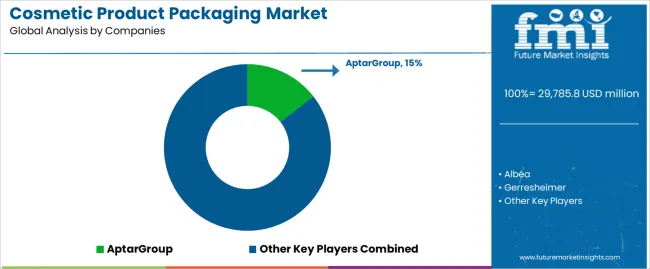
The cosmetic product packaging market is characterized by competition among established packaging manufacturers, specialized beauty packaging producers, and integrated material science solutions providers. Companies are investing in smart packaging technology research, sustainable material optimization, premium aesthetics development, and comprehensive product portfolios to deliver consistent, high-performance, and application-specific cosmetic packaging solutions. Innovation in digital printing systems, barrier coating integration, and consumer experience enhancement is central to strengthening market position and competitive advantage.
AptarGroup leads the cosmetic product packaging market with a strong market share, offering comprehensive dispensing and packaging solutions including advanced pump systems with a focus on luxury beauty and personal care applications. Albéa provides specialized tube packaging capabilities with an emphasis on cosmetic applications and premium brand positioning. Gerresheimer delivers innovative glass packaging products with a focus on high-end cosmetics and pharmaceutical beauty applications. LUMSON specializes in luxury packaging design and premium cosmetic containers for high-value beauty products. HCP Packaging focuses on comprehensive beauty packaging solutions and integrated manufacturing capabilities. silgan Holdings offers specialized metal and plastic packaging with emphasis on consumer goods and beauty applications.
| Items | Values |
|---|---|
| Quantitative Units (2025) | USD 29,785.8 million |
| Material Type | Plastic, Glass, Metal, Paper & Paperboard |
| Application | Skincare, Makeup, Fragrance, Hair Care, Others |
| Packaging Format | Bottles, Jars, Tubes, Compacts, Pumps & Dispensers |
| Distribution Channel | Retail Stores, E-Commerce, Specialty Stores, Direct-to-Consumer |
| Regions Covered | North America, Europe, East Asia, South Asia & Pacific, Latin America, Middle East & Africa |
| Countries Covered | China, India, Germany, Brazil, United States, United Kingdom, Japan and 40+ countries |
| Key Companies Profiled | AptarGroup, Albéa, Gerresheimer, LUMSON, HCP Packaging, and silgan Holdings |
| Additional Attributes | Dollar sales by material type and application category, regional demand trends, competitive landscape, technological advancements in smart packaging systems, premium aesthetics development, digital integration innovation, and beauty industry integration |
The global cosmetic product packaging market is estimated to be valued at USD 29,785.8 million in 2025.
The market size for the cosmetic product packaging market is projected to reach USD 48,518.0 million by 2035.
The cosmetic product packaging market is expected to grow at a 5.0% CAGR between 2025 and 2035.
The key product types in cosmetic product packaging market are plastic, glass, metal and paper & paperboard.
In terms of application, skincare segment to command 42.5% share in the cosmetic product packaging market in 2025.






Our Research Products

The "Full Research Suite" delivers actionable market intel, deep dives on markets or technologies, so clients act faster, cut risk, and unlock growth.

The Leaderboard benchmarks and ranks top vendors, classifying them as Established Leaders, Leading Challengers, or Disruptors & Challengers.

Locates where complements amplify value and substitutes erode it, forecasting net impact by horizon

We deliver granular, decision-grade intel: market sizing, 5-year forecasts, pricing, adoption, usage, revenue, and operational KPIs—plus competitor tracking, regulation, and value chains—across 60 countries broadly.

Spot the shifts before they hit your P&L. We track inflection points, adoption curves, pricing moves, and ecosystem plays to show where demand is heading, why it is changing, and what to do next across high-growth markets and disruptive tech

Real-time reads of user behavior. We track shifting priorities, perceptions of today’s and next-gen services, and provider experience, then pace how fast tech moves from trial to adoption, blending buyer, consumer, and channel inputs with social signals (#WhySwitch, #UX).

Partner with our analyst team to build a custom report designed around your business priorities. From analysing market trends to assessing competitors or crafting bespoke datasets, we tailor insights to your needs.
Supplier Intelligence
Discovery & Profiling
Capacity & Footprint
Performance & Risk
Compliance & Governance
Commercial Readiness
Who Supplies Whom
Scorecards & Shortlists
Playbooks & Docs
Category Intelligence
Definition & Scope
Demand & Use Cases
Cost Drivers
Market Structure
Supply Chain Map
Trade & Policy
Operating Norms
Deliverables
Buyer Intelligence
Account Basics
Spend & Scope
Procurement Model
Vendor Requirements
Terms & Policies
Entry Strategy
Pain Points & Triggers
Outputs
Pricing Analysis
Benchmarks
Trends
Should-Cost
Indexation
Landed Cost
Commercial Terms
Deliverables
Brand Analysis
Positioning & Value Prop
Share & Presence
Customer Evidence
Go-to-Market
Digital & Reputation
Compliance & Trust
KPIs & Gaps
Outputs
Full Research Suite comprises of:
Market outlook & trends analysis
Interviews & case studies
Strategic recommendations
Vendor profiles & capabilities analysis
5-year forecasts
8 regions and 60+ country-level data splits
Market segment data splits
12 months of continuous data updates
DELIVERED AS:
PDF EXCEL ONLINE
Cosmetic Packaging Market Size and Share Forecast Outlook 2025 to 2035
Cosmetic Tube Packaging Market Size and Share Forecast Outlook 2025 to 2035
CBD Product Packaging Market Size and Share Forecast Outlook 2025 to 2035
Competitive Overview of CBD Product Packaging Market Share
Cosmetic Plastic Packaging Market Size and Share Forecast Outlook 2025 to 2035
Eye Cosmetic Packaging Market Size and Share Forecast Outlook 2025 to 2035
Cosmetic Surgery Products Market Analysis - Size, Share, and Forecast Outlook 2025 to 2035
Market Share Insights of Eye Cosmetic Packaging Providers
Dairy Product Packaging Market Size and Share Forecast Outlook 2025 to 2035
Market Share Breakdown of Dairy Product Packaging Companies
Make-Up Products Packaging Market Size and Share Forecast Outlook 2025 to 2035
Single Portion Cosmetic Packaging Market Size and Share Forecast Outlook 2025 to 2035
Competitive Overview of Single Portion Cosmetic Packaging Companies
Anti-counterfeit Cosmetic Packaging Market Growth - Demand & Forecast 2025 to 2035
Injection Moulding Cosmetic Packaging Market Size and Share Forecast Outlook 2025 to 2035
Market Share Distribution Among Injection Moulding Cosmetic Packaging Manufacturers
Product Tour Software for SaaS Market Size and Share Forecast Outlook 2025 to 2035
Packaging Supply Market Size and Share Forecast Outlook 2025 to 2035
Packaging Testing Services Market Size and Share Forecast Outlook 2025 to 2035
Packaging Tubes Market Size and Share Forecast Outlook 2025 to 2035

Thank you!
You will receive an email from our Business Development Manager. Please be sure to check your SPAM/JUNK folder too.
Chat With
MaRIA